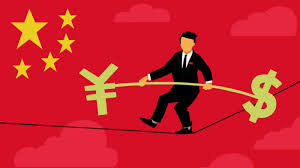
Pic courtesy: knnindia.co.in
Several factors including the spread of COVID-19 and the Ukraine crisis have created a state of complex, severe, and uncertain economic conditions throughout the world. Countries the world over are trying to re-energise their economies.
Chinese Aim. China has two economic aims. The first is to ensure that the yearly GDP growth target of 5.5 percent is attained. The second is that the Chinese economy expands at a higher rate than that of the United States to demonstrate “the superiority of the Chinese system”.

Pic Courtesy: vifindia.org
Reasons for the Chinese economy taking a beating.
- COVID-19 outbreak in major cities including Shanghai and Beijing.
- Snarled logistics, faltering manufacturing output, and lagging consumer spending.
- Chinese companies listed on the New York Stock Exchange and Nasdaq were asked to quit the U.S. market to avoid possible “leakage of state secrets”.
- China’s tit for tat approach toward Washington’s decision to bar American businesses from investing in Chinese companies with links to the military and intelligence.
Self-inflicted Injuries. The policy of “common prosperity” was used as a pretext to squeeze domestic tycoons. The ambitious expansion plan of IT giants (Alibaba’s Ant Group and Didi Chuxing), private education companies, and video game producers were suppressed. Billions of yuan worth of fines were levied upon e-commerce firms (Alibaba and Tencent) for allegedly failing to observe market regulations and several IT tycoons (including Ma Yun and Ma Huateng) were forced to donate billions of yuan to state coffers.
Power Struggle. China has complex dynamics of a power struggle like “The game of thrones”. By actions taken above, Xi has weakened the business tycoons, shown them their place in the power hierarchy, and taken their money to inject it into the faltering economy.
Policy U-Turn. China has now liberalised measures on its technology firms, announcing a policy to promote a “healthy development” of the internet platform economy through “normalizing control over the tech sector,” and specific measures to boost high technology industries (especially information technology).
Tighter Control. Xi has stated at a politburo study session that different types of capital (state capital, the capital of collectives, private capital, foreign capital, and firms with mixed capital components) are allowed to co-exist in socialist China. However, he emphasised the necessity for strict control (supervision and management) over them. This signals that the high-tech multinationals and successful enterprises will continue to be controlled by party.
Other Measures. China has devised multi-pronged tactics to boost the economy.
- Lowering interest and mortgage rates as well as the reserve requirements for banks.
- Encouraging the domestic market by making spending coupons worth 500 million yuan being made available to citizens.
- An ambitious program to boost infrastructure development with priority allocated to the telecommunications, electricity, waterworks, transport, and energy sectors.
- Earmarking of a multi-billion yuan budget for cutting-edge technologies such as artificial intelligence, quantum computing, microchips, and logistics to offset decoupling attempts by the west.
Concept of United National Market. China is pursuing this concept to curb artificially demarcated regional markets and open up key blockades which limit national economic circulation. China feels that this concept will eliminate bureaucratic red tape and prevent provincial protectionism while ensuring fair competition and full transparency.
Theory of Internal Circulation. This is a strategy to reorient China’s economy by prioritising domestic consumption. Internal circulation is seen as laying the groundwork for self-reliance should further decoupling between the Chinese and U.S. markets occur.
Balancing of Re-energising the Economy and Consolidating Power. The concepts of internal circulation and a united national market would allow the party leadership to enforce state plans and curtail decentralized decision-making.
China is deciding its economic policies based on both external and internal power struggle aspects. The 20th party congress is planned for the latter half of the year. The future of these policies would be clearer after the meeting.
Bottom Line
De-coupling with China is not easy.
Question
will China be able to sustain her economic growth?
Suggestions and value additions are most welcome
For regular updates, please register here
References and credits
To all the online sites and channels.
